三毛英文简介
- 格式:ppt
- 大小:1.43 MB
- 文档页数:20
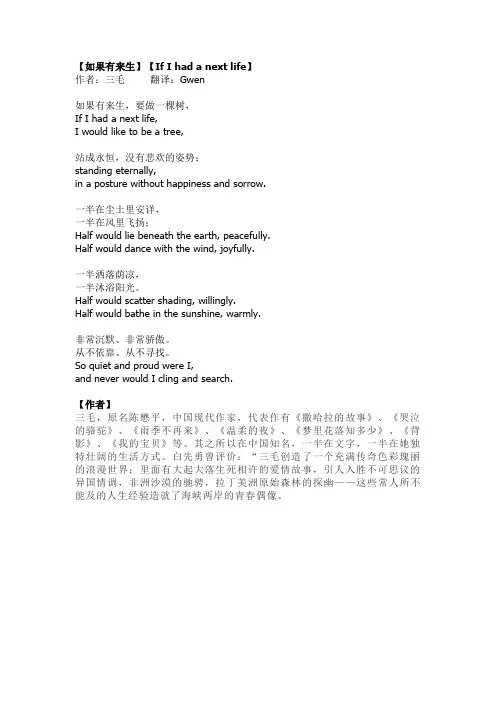
【如果有来生】【If I had a next life】
作者:三毛翻译:Gwen
如果有来生,要做一棵树,
If I had a next life,
I would like to be a tree,
站成永恒,没有悲欢的姿势;
standing eternally,
in a posture without happiness and sorrow.
一半在尘土里安详,
一半在风里飞扬;
Half would lie beneath the earth, peacefully.
Half would dance with the wind, joyfully.
一半洒落荫凉,
一半沐浴阳光。
Half would scatter shading, willingly.
Half would bathe in the sunshine, warmly.
非常沉默、非常骄傲。
从不依靠、从不寻找。
So quiet and proud were I,
and never would I cling and search.
【作者】
三毛,原名陈懋平,中国现代作家,代表作有《撒哈拉的故事》、《哭泣的骆驼》、《雨季不再来》、《温柔的夜》、《梦里花落知多少》、《背影》、《我的宝贝》等。
其之所以在中国知名,一半在文字,一半在她独特壮阔的生活方式。
白先勇曾评价:“三毛创造了一个充满传奇色彩瑰丽的浪漫世界;里面有大起大落生死相许的爱情故事,引人入胜不可思议的异国情调,非洲沙漠的驰骋,拉丁美洲原始森林的探幽——这些常人所不能及的人生经验造就了海峡两岸的青春偶像。
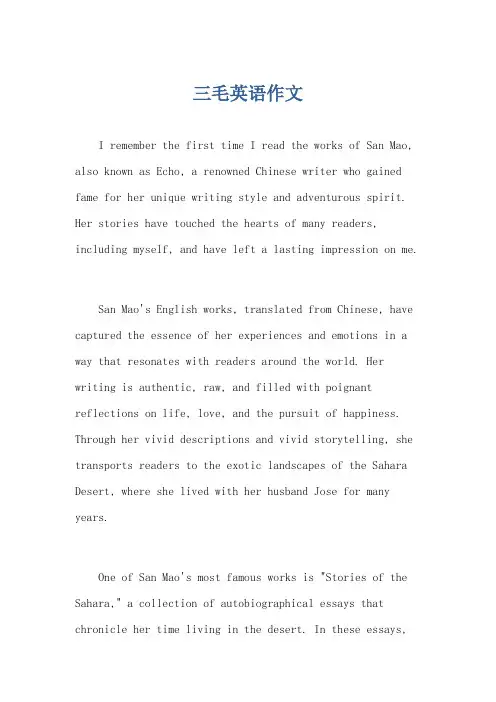
三毛英语作文I remember the first time I read the works of San Mao, also known as Echo, a renowned Chinese writer who gained fame for her unique writing style and adventurous spirit. Her stories have touched the hearts of many readers, including myself, and have left a lasting impression on me.San Mao's English works, translated from Chinese, have captured the essence of her experiences and emotions in a way that resonates with readers around the world. Her writing is authentic, raw, and filled with poignant reflections on life, love, and the pursuit of happiness. Through her vivid descriptions and vivid storytelling, she transports readers to the exotic landscapes of the Sahara Desert, where she lived with her husband Jose for many years.One of San Mao's most famous works is "Stories of the Sahara," a collection of autobiographical essays that chronicle her time living in the desert. In these essays,she recounts the challenges and triumphs of adapting to a harsh environment, the beauty of the desert landscape, and the deep connections she formed with the local Bedouin people. Her writing is both poetic and profound, capturing the essence of the human experience in a way that is both universal and deeply personal.Another notable work by San Mao is "The Rice Sprout Song," a novel set during the Chinese Cultural Revolution. The novel follows the story of a young girl named Han Ying, who struggles to survive and find meaning in a time of great turmoil and upheaval. Through Han Ying's eyes, we see the impact of political ideology on individual lives, the power of resilience and hope, and the enduring strength of the human spirit.San Mao's writing is characterized by its honesty, vulnerability, and emotional depth. She bares her soul on the page, sharing her joys, sorrows, fears, and dreams with an openness that is both refreshing and inspiring. Her words have a timeless quality that transcends language andcultural barriers, speaking to the universal truths of the human experience.In conclusion, San Mao's English works are a testament to the power of storytelling and the enduring legacy of a talented writer. Through her words, she invites readers to journey with her through the highs and lows of life, to explore the depths of the human heart, and to find beauty and meaning in the most unexpected places. San Mao's English works have left an indelible mark on the literary world, and her legacy continues to inspire and captivate readers to this day.。
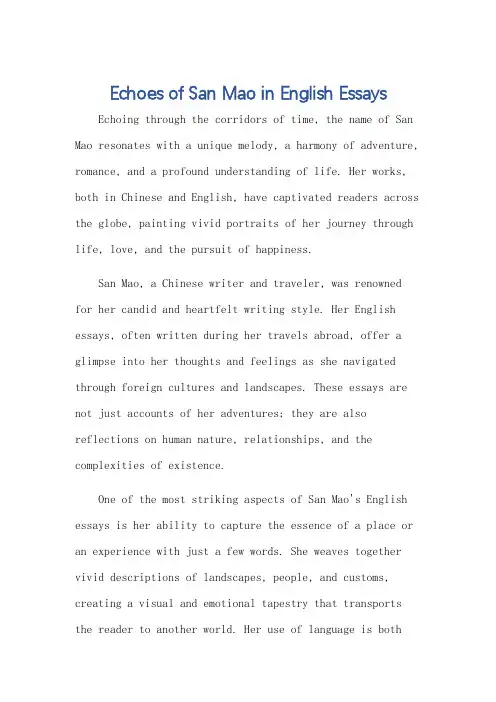
Echoes of San Mao in English EssaysEchoing through the corridors of time, the name of San Mao resonates with a unique melody, a harmony of adventure, romance, and a profound understanding of life. Her works, both in Chinese and English, have captivated readers across the globe, painting vivid portraits of her journey through life, love, and the pursuit of happiness.San Mao, a Chinese writer and traveler, was renownedfor her candid and heartfelt writing style. Her English essays, often written during her travels abroad, offer a glimpse into her thoughts and feelings as she navigated through foreign cultures and landscapes. These essays are not just accounts of her adventures; they are also reflections on human nature, relationships, and the complexities of existence.One of the most striking aspects of San Mao's English essays is her ability to capture the essence of a place or an experience with just a few words. She weaves together vivid descriptions of landscapes, people, and customs, creating a visual and emotional tapestry that transports the reader to another world. Her use of language is bothpoetic and profound, revealing a deep understanding of the world and its inhabitants.Moreover, San Mao's essays are filled with insights on love and relationships. She writes candidly about her own experiences, sharing both the joys and the pains of being in love. Her essays explore the nuances of emotional connections, the challenges of maintaining relationships, and the transformative power of love.Beyond the personal, San Mao's essays also delve into broader themes of life and existence. She reflects on the meaning of life, the pursuit of happiness, and the challenges faced by individuals in a world that is often unpredictable and unfair. Her thoughts are both profound and Insightful, offering readers a new perspective on life and its complexities.The popularity of San Mao's English essays can be attributed to their accessibility and relatability. Her writing style is direct and honest, making it easy for readers to connect with her thoughts and feelings. Her essays are not just for Chinese readers; they speak to auniversal audience, resonating with people across cultures and backgrounds.In conclusion, San Mao's English essays are a testament to her writing prowess and her unique understanding of life. They offer readers a window into her world, a world that is both familiar and exotic, filled with adventure, romance, and profound insights on life and love. As we continue to explore and understand the world, San Mao's essays remain a valuable resource, providing us with insights andinspiration that are as relevant today as they were whenshe first penned them.**三毛英语作文的回响**时光的长廊中,三毛的名字以其独特的旋律回荡着,那是冒险、浪漫和对生活的深刻理解的和谐之声。

三毛本名陈平,一九四三年三月二十六日生,浙江省定海县人,中国文化大学哲学系。
肄业曾留学欧洲,婚后定居西属撒哈拉沙漠迦纳利岛,并以当地的生活为背景,写出一连串脍炙人口的作品。
一九八一年回台后,曾在文化大学任教,一九八四年辞去教职,而以写作、演讲为重心。
一九九一年一月四日去世,享年四十八岁。
她的足迹遍及世界各地,她的作品也在全球的华人社会广为流传,在大陆也有广大的读者,生平著作和译作十分丰富。
共有二十四种。
三毛英文名叫ECHO,三毛本是笔名,从三毛的《闹学记》序中只提及“三毛”二字中暗藏一个易经的卦。
但又是什么玄机,就不得而知了。
但三毛本人又曾说过:起初起此名,是因为这个名字很不起眼,另有一个原因就是说自己写的东西很一般,只值三毛钱。
三毛于1943年3月26日(农历2月21日)生于四川重庆。
幼年时期的三毛就表现对书本的爱好,5岁半时就在看《红楼梦》。
初中时期几乎看遍了市面上的世界名著。
初二那年休学,由父母亲悉心教导,在诗词古文、英文方面,打下次坚实的基础。
并先后跟随顾福生、邵幼轩两位画家习画。
1964年,得到文化大学创办人张其均先生的特许,到该校哲学系当旁听生,课业成绩优异。
1967年再次休学,只身远赴西班牙。
在三年之间,前后就读西班牙马德里大学、德国哥德书院,在美国伊诺大学法学图书馆工作。
对她的人生经验和语文进修上有很大助益。
1970年回国,受张其均先生之邀聘在文大德文系、哲学系任教。
后因未婚夫猝逝,她在哀痛之余,再次离开,又到西班牙。
与苦恋她6年的荷西重逢。
1973年,于西属撒哈拉沙漠的当地法院,与荷西公证结婚。
在沙漠时期的生活,激发她潜藏的写作华,并受当时《联合报》主编的鼓励,作品源源不断,并且开始结集出书。
第一部作品《撒哈拉的故事》在1976年5月出版。
1979年9月30日夫婿荷西因潜水意外事件丧生,回到台湾。
1981年,三毛决定结束流浪异国14年的生活,在国内定居。
同年1月,《联合报》特别赞助她往中南美洲旅行半年,回来后写成《万水千山走遍》,并作环岛演讲。
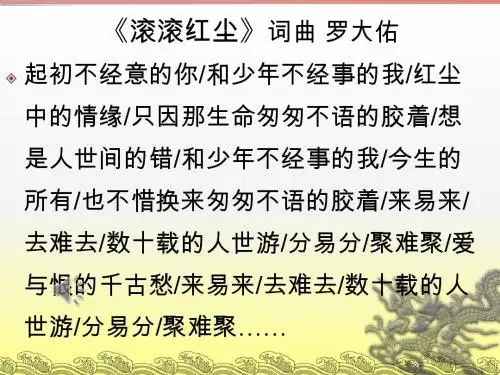

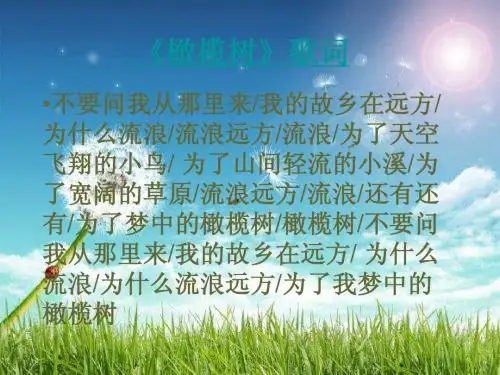


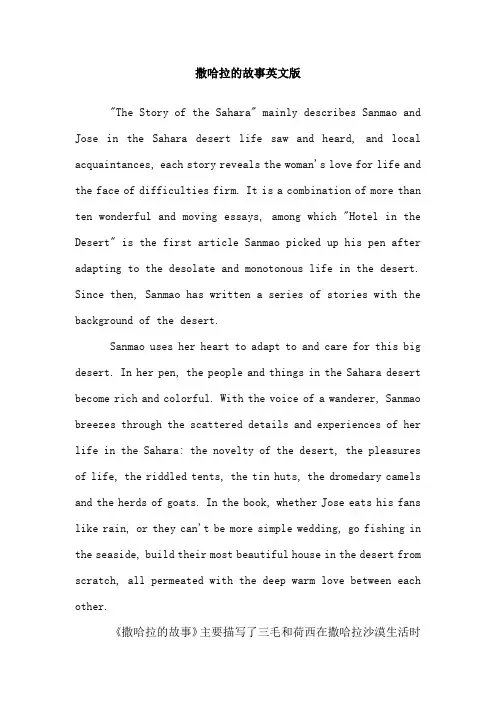
撒哈拉的故事英文版"The Story of the Sahara" mainly describes Sanmao and Jose in the Sahara desert life saw and heard, and local acquaintances, each story reveals the woman's love for life and the face of difficulties firm. It is a combination of more than ten wonderful and moving essays, among which "Hotel in the Desert" is the first article Sanmao picked up his pen after adapting to the desolate and monotonous life in the desert. Since then, Sanmao has written a series of stories with the background of the desert.Sanmao uses her heart to adapt to and care for this big desert. In her pen, the people and things in the Sahara desert become rich and colorful. With the voice of a wanderer, Sanmao breezes through the scattered details and experiences of her life in the Sahara: the novelty of the desert, the pleasures of life, the riddled tents, the tin huts, the dromedary camels and the herds of goats. In the book, whether Jose eats his fans like rain, or they can't be more simple wedding, go fishing in the seaside, build their most beautiful house in the desert from scratch, all permeated with the deep warm love between each other.《撒哈拉的故事》主要描写了三毛和荷西在撒哈拉沙漠生活时的所见所闻,与当地相识朋友的故事,每个故事都透露出这个隐忍女子对生活的热爱和面对困难的坚定。

三毛流浪记的英语作文San Mao's wanderings are a poignant tale of resilience and adventure. Her journey, filled with both hardship and discovery, resonates with readers of all ages.Born into a world that often seemed unkind, San Mao's spirit never waned. With every new place she explored, she found a piece of herself, learning to adapt and thrive in diverse environments.Her stories are a testament to the human spirit's ability to find beauty in the most unexpected corners of the world. Through her eyes, we witness the transformation of a young girl into a woman of the world.In her travels, San Mao encountered people from all walks of life, each with their own stories to tell. These encounters enriched her life, teaching her about the complexities of human nature and the universality of love and loss.Despite the challenges she faced, San Mao's love for life was unwavering. Her writings are a beacon of hope, reminding us that even in the darkest of times, there is always a glimmer of light to be found.Her experiences with different cultures and landscapes shaped her worldview, showing her the interconnectedness ofall people and the importance of empathy and understanding.San Mao's legacy is one of courage and curiosity. Herlife serves as a reminder that no matter where we come from, we are all capable of great journeys and profound growth.In the end, San Mao's wanderings were not just a physical journey, but a spiritual one as well. Through her travels, she found a deeper understanding of herself and her place in the world, inspiring us all to embark on our own voyages of self-discovery.。
三毛介绍英语作文When it comes to English essay writing, many students mayfeel overwhelmed by the task. However, with a structured approach and a clear understanding of the components thatmake up a good essay, the process can be much more manageable. Here's a guide to English essay writing inspired by the free-spirited and thoughtful insights of Sanmao, the renowned Chinese writer.Understanding the Essay Structure1. Thesis Statement: This is the core idea of your essay.It's like the heart of a tree, giving life to the entire composition. Be clear and concise, just as Sanmao's proseoften was.2. Introduction: This is where you hook your reader. Startwith an interesting fact, a question, or a quote that relates to your thesis. It's like the first step on a journey thatyou're inviting your reader to take with you.3. Body Paragraphs: Each paragraph should focus on one main idea that supports your thesis. Use evidence from your research—quotes, statistics, examples—to back up your points. Sanmao's detailed observations of life can be a great example of how to provide rich, supporting details.4. Conclusion: Summarize your main points and restate yourthesis in a new way. End with a final thought that leaves a lasting impression on your reader, much like the poignant endings of Sanmao's stories.Developing Your Writing Skills1. Vocabulary: Expand your vocabulary to express your ideas more precisely. Sanmao's work is filled with vivid and expressive language that can inspire you to find the right words for your essay.2. Grammar: A strong command of grammar is essential. Errors can distract from your message. Practice and review to ensure your sentences are grammatically correct.3. Coherence and Cohesion: Ensure your essay flows logically from one point to the next. Use transitional phrases to guide your reader through your argument.4. Editing and Proofreading: Never underestimate the power of revision. Sanmao was known to revise her work multiple times to achieve clarity and impact. Read your essay aloud to catch awkward phrasings and typos.Finding Your VoiceSanmao's writing is characterized by its authenticity and emotional depth. As you write your essay, strive to find a voice that is true to you. Be honest and genuine in expressing your thoughts and ideas.Tips for Success1. Plan Ahead: Before you start writing, outline your essay. Knowing where you're going can make the writing process smoother.2. Read Widely: The more you read, the better you'll understand how to construct sentences and develop arguments.3. Practice Regularly: Writing is a skill that improves with practice. Write essays on different topics to become more versatile.4. Seek Feedback: Have peers or teachers review your work. Constructive criticism can be invaluable for improvement.5. Stay Inspired: Read Sanmao's works for inspiration. Her unique perspective and storytelling can motivate you to think creatively.By embracing the structure and developing your skills, you can write an English essay that is not only academically sound but also a reflection of your unique voice and perspective. Remember, writing is an art, and like Sanmao, you too can craft essays that are both informative and engaging.。
三年级作文我最喜欢的一本书三毛流浪记英文版My Favorite Book: "The Story of Three Hairs"In the third grade, I discovered a book that quickly became my all-time favorite. It was "The Story of Three Hairs" by Sanmao. This book tells the story of a little girl named Sanmao who goes on a journey with her three hairs – Black, White, and Gray.Sanmao and her three hairs travel to different places, meet interesting characters, and have all sorts of adventures. From the bustling city to the quiet countryside, Sanmao and her hairs experience it all. Along the way, they learn valuable lessons about friendship, courage, and the importance of being true to oneself.What I love most about this book is the way it transports me to different worlds and teaches me important life lessons. Sanmao's courage and curiosity inspire me to be brave and explore new things. Her friendship with her three hairs reminds me of the importance of cherishing the people who are always by my side."The Story of Three Hairs" is a book that I will always hold dear to my heart. It has taught me so much and brought me so much joy. I hope that others will also discover the magic of this wonderful book and be inspired by Sanmao's adventures.完整中文翻译我最喜欢的书:《三毛流浪记》在三年级时,我发现了一本让我立刻爱上的书。